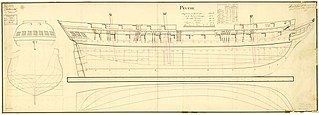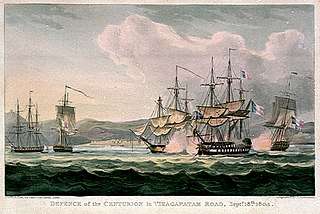Career
Captain C.A. Sheen sailed from Calcutta on 18 June 1801, bound for London. Gilwell was at Madras on 11 September and the Cape on 24 December. She reached St Heleana on 28 January 1802, and arrived at Blackwall on 15 April. [3] On her return to India, Gilwell carried the English painter George Chinnery as a passenger.
In 1803 Gilwell appeared on a list of vessels belonging to Madras. C.A.Sheen was still her master. [4]
On 14 February 1804 Gilwell was present at the battle of Pulo Aura, though she did not participate in the engagement. The EIC China Fleet was returning from Canton, bound for London. A number of country ships returning to India were part of the fleet.
On 8 January 1805 the French frigate Psyché captured Gilwell as Gilwell was sailing from Bengal to Bombay. However, Psyché gave her up as Psyché did not have the crew to man Gilwell. Shortly thereafter HMS St Fiorenzo captured Psyché and carried her into Bengal. [6] Gilwell arrived in the Ganges on 16 January. [7]
In 1807 the French captured Gillwell in the Bay of Bengal. [8] She was one of some 14 ships that the French captured in the Indian Ocean between August and October 1807.
On 1 November 1807 at Port Napoleon, William Richardson, late master of Althea, C. Bean, late master of Gilwell, R. Dickie, late master of Elizabeth, and some others wrote a letter to Léonard Motard, captain of Sémillante, for his kind and courteous treatment of them while they were his prisoners. [9] This would suggest that it was Sémillante, rather than a privateer, that had captured Gilwell.
Her captors sold Gilwell to Arabs at Jiddah, who renamed her Fyzal Curreem.
She later became a rebuilt razee under the name Cashmere Merchant.
The 1819 and 1824 volumes of the East-India directory made no mention in list of vessels belonging to Calcutta, Madras, or Bombay under any name.
The 1827 volume of the East India directory showed Cashmere Merchant as belonging to Calcutta. Her master was Thomas Woodley, and her managing owner was Shaik Abdullah. [1] The 1829 volume did not report the names of her master or managing owner, but it did describe her as being built at Howrah. [11]
In the 1830s Cashmere Merchant was reported trading from Calcutta with China, Burma, Mauritius, and Singapore.

Psyché was a 36-gun vessel built between February 1798 and 1799 at Basse-Indre (Nantes) as a privateer. As a privateer she had an inconclusive but bloody encounter with HMS Wilhelmina of the Royal Navy, commanded by Commander Henry Lambert, off the Indian coast in April 1804. The French then brought her into service in June 1804 as the frigate Psyché. In February 1805 she encountered San Fiorenzo, under the command of the same Henry Lambert, now an acting captain. After a sanguinary engagement of over three hours, Psyché surrendered. The British took her into service as HMS Psyche. In British service she captured several prizes and took part in the capture of Mauritius and in an operation in Java. She was broken up at Ferrol in 1812.

The Battle of Vizagapatam was a minor naval engagement fought in the approaches to Vizagapatam harbour in the Coastal Andhra region of British India on the Bay of Bengal on 15 September 1804 during the Napoleonic Wars. A French squadron under Contre-Admiral Charles-Alexandre Léon Durand Linois in the ship of the line Marengo attacked the British Royal Navy fourth rate ship HMS Centurion and two East Indiaman merchant ships anchored in the harbour roads. Linois was engaged in an extended raiding campaign, which had already involved operations in the South China Sea, in the Mozambique Channel, off Ceylon and along the Indian coast of the Bay of Bengal. The French squadron had fought one notable engagement, at the Battle of Pulo Aura on 15 February 1804, in which Linois had attacked the Honourable East India Company's (HEIC) China Fleet, a large convoy of well-armed merchant ships carrying cargo worth £8 million. Linois failed to press the attack and withdrew with the convoy at his mercy, invoking the anger of Napoleon when the news reached France.
Zenobia was a merchant ship launched in 1815 at Calcutta, India. She traded with India under license from the British East India Company (EIC), and made one voyage for the EIC. She then became a Free Trader. In 1852 the P&O company purchased Zenobia to use her as a coal hulk. She was broken up in 1871.
Mornington was a British merchant vessel built of teak and launched in 1799 at Calcutta. She made three voyages under charter to the British East India Company (EIC). On the third French privateers twice captured her and Royal Navy vessels twice recaptured her. A fire destroyed her in 1815.
Althea was launched at Calcutta in 1801. She made one voyage to Britain for the British East India Company. The French captured her in the Indian Ocean in 1804 and then kept her at Île de France where she served as a prison ship. When the British captured Île de France in 1810 they recovered Althea. She then resumed her mercantile career until she wrecked in 1812.
Charlotte was built at the Bombay Dockyard in 1803. She spent most of her career as a country ship, trading between India and China. The French captured her in 1804 but she returned to British hands. She was wrecked in 1851.
Hope was launched in 1804 at Calcutta. She made one voyage for the British East India Company (EIC). She continued to trade around India until a French frigate captured her in 1808. She apparently returned to English hands and was renamed Madras Merchant. She was then sold in 1816 at Manila.
Eliza Ann was launched at Calcutta in 1795. She sailed to England where she was admitted to the Registry. In all, she made five voyages for the British East India Company (EIC), during one of which she participated in a notable action and during the last of which she captured a French privateer. She herself was lost in 1807.
Countess of Sutherland was launched in 1801 at Tittaghur on the Hooghly River, about 15 miles upstream from Calcutta. She made one voyage from Calcutta to England for the British East India Company in 1801–1802. The French captured her in 1803 as she was sailing from Bengal to China. They used her as a hulk until she was broken up c.1821.
Moira, was launched at Calcutta in 1813. Between 1820 and 1834 she made four voyages for the British East India Company (EIC) under voyage charters, and transported troops to Burma in 1824. She was lost in 1844.
Upton Castle was launched at Bombay in 1793. She spent her career as a "country ship", that is trading in the Far East. She made some voyages to England, including at least one, in 1809, under charter to the British East India Company (EIC). She also participated in two military campaigns as a transport. The French Navy captured her in 1804, but she returned to British hands before 1809. A fire in 1817 destroyed her.
Stirling Castle was built at Calcutta in 1801. She made one voyage from Calcutta to England for the British East India Company (EIC).
Sir Andrew Snape Hammond was a merchant vessel launched at Calcutta in 1802. By 1807 her name had changed to Udny. In 1807 the French captured her, but she eventually returned to non-French ownership and Calcutta registry. She was wrecked in 1824.
Huddart was launched in 1803 as an East Indiaman. She made eight voyages for the British East India Company (EIC), between 1803 and 1818. In 1810-1811 she participated as a transport in two British military campaigns. In 1818 new owners deployed her in sailing to Canada. She was wrecked there in 1821.
Susan was launched at Calcutta in 1813. She initially traded in the East Indies as a country ship, and with Britain under license from the British East India Company (EIC). Between 1829 and 1831 she made two voyages for the EIC. Then between 1834 and 1836 she made four voyages transporting convicts, two to New South Wales, and two to Tasmania. She foundered in 1846 as she was sailing between London and the Cape of Good Hope.
Union was launched at Calcutta in 1801. She sailed to England and then made five voyages as an East Indiaman for the British East India Company (EIC), between 1805 and 1814. She was wrecked in late 1815 or early 1816.
City of London was launched in 1800 as an East Indiaman. She made six voyages for the British East India Company (EIC) between 1800 and 1814 when she was taken up as a troopship for one voyage. She made one more voyage to India under a license from the EIC and then was broken up circa 1817.
Fairlie was launched at Calcutta in 1810 and sailed to England. There she became a regular ship for the British East India Company (EIC). Including her voyage to England, she made four voyages for the EIC. From around 1821 on she became a Free Trader, continuing to trade with India under a license from the EIC. She also made two voyages transporting convicts to New South Wales (1834), and Tasmania (1852). She made several voyages carrying immigrants to South Australia, New South Wales, and British Guiana. She foundered in November 1865.
Ceres was launched at Kolkata in August 1793 as Lutchmy and renamed in 1794. She sailed to England in 1798 and became a West Indiaman. She was condemned at Barbados in 1806. New owners returned her to service, first as a West Indiaman and then as an East Indiaman. She was damaged at Mauritius in 1818 and although she was listed until 1824, it is not clear that she sailed again after the damage she sustained in Mauritius.
Diana was launched in 1799 as a West Indiaman. From 1805 she made four voyages as an East Indiaman under charter to the British East India Company. She made a fifth voyage to India in 1817 under a license from the EIC. She ran into difficulties in the Hooghly River while homeward bound and was condemned in Bengal in June 1818.

